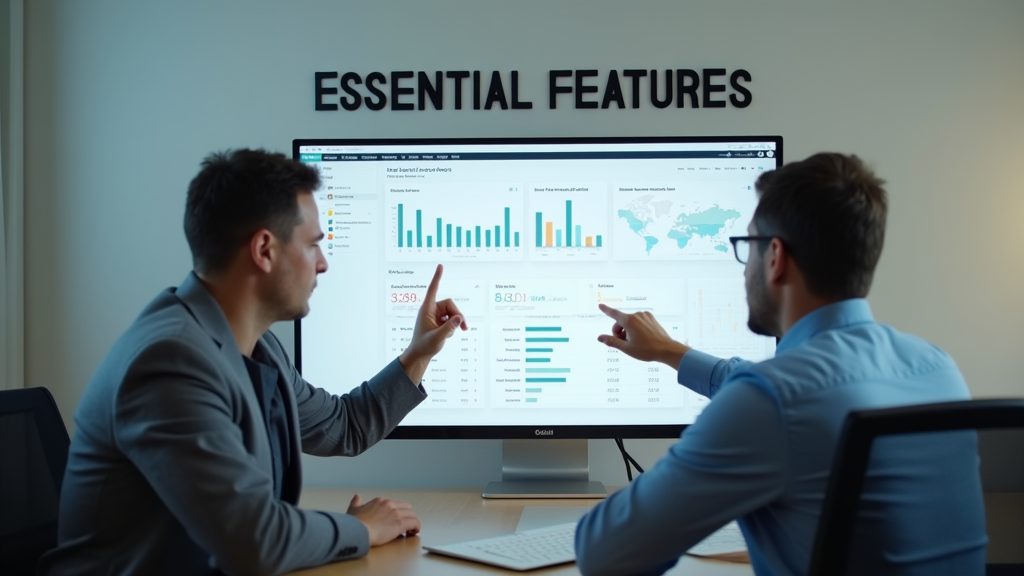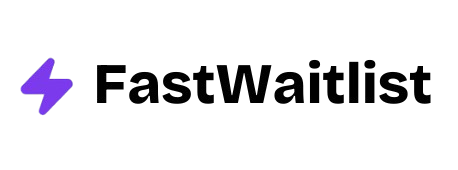
Introduction
Waitlists started as simple first-come, first-served lines. Today, digital waitlists help you build excitement, gather valuable customer information, and create buzz around your product launch. Your potential customers now expect more than just a spot in line. They want updates, engagement, and a clear path to getting your product.
Managing a growing waitlist brings several challenges. You need to keep track of signups, send regular updates, and make sure people stay interested. Without the right tools, you might lose potential customers or miss opportunities to learn from their feedback. Many businesses struggle to turn their waitlist into a valuable marketing asset.
FastWaitlist gives you the tools to handle these challenges. You can easily collect signups, send automated updates, and track engagement with your waitlist. Your waitlist becomes more than a list of names. It turns into a powerful way to understand your market and build relationships with future customers before launch.
Understanding Waitlist Management
A waitlist helps you organize potential customers who want your product before it's available. Modern businesses manage waitlists to build excitement and create a smooth path from interest to purchase. Your waitlist can become a powerful tool to understand customer needs and plan your product launch better.
Successful waitlist management involves several important parts working together. You'll need a way to collect and store contact information, send updates to interested people, and track how many spots are available. The most important part is keeping your future customers excited and interested while they wait. Regular communication and special perks for waitlist members can make a big difference in keeping people engaged.
Strategic waitlist management goes beyond the old way of just making a list of names. While traditional waitlists were simple first come, first served systems, modern approaches focus on building relationships with future customers. You can learn from how people interact with your updates, gather feedback about what they want, and use this information to make your product better. This helps turn waiting customers into active supporters of your business.
Benefits of Strategic Waitlist Management
A well-managed waitlist can become your most valuable marketing tool. You can build excitement, understand your market better, and launch your product with confidence when you have a group of interested users waiting to try it.
- Market Validation: See if people actually want your product before full launch
- Marketing Power: Create buzz and word-of-mouth promotion naturally
- User Insights: Learn about your potential customers through signup data and feedback
- Growth Control: Scale your product at a pace that works for your team
Some of the most successful tech products started with smart waitlist strategies. Gmail launched with an invite-only system that made email addresses highly desired. Clubhouse used its waitlist to create massive interest, growing from 1,500 to 2 million users in less than a year through their invite system.
FastWaitlist helps you get these benefits without the technical headaches. You can set up your waitlist in minutes, collect valuable user data, and manage your launch effectively. The platform includes tools for referral programs, analytics, and automated email campaigns to keep your waitlist engaged until launch day.

Essential Waitlist Features
Your waitlist tools need specific features to work well and keep potential customers interested. A good waitlist system helps you collect information, keep people excited, and turn waiting into an opportunity for growth.
1. Signup Form Optimization
Create simple forms that collect important customer information without asking for too much. Your form should work well on phones and computers, and load quickly.
2. Automated Communications
Send welcome messages, updates, and reminders to keep people interested. You can schedule these messages to go out at the right time for each person on your list.
3. Position Tracking
Let people see where they are in line. This helps build excitement and keeps them engaged while they wait for your product launch.
4. Referral Systems
Add ways for people to invite others and move up in line. This helps your waitlist grow naturally and rewards your most interested customers.
These features work together to create value for both you and your waiting customers. While people wait, you can learn about them, keep them excited, and grow your audience. The right mix of these tools helps turn your waitlist from a simple queue into a powerful marketing tool.
Setting Up Your Waitlist Strategy
A good waitlist strategy helps you manage customer interest and build excitement for your product launch. You need a clear plan to collect, engage, and convert interested customers into paying users. Your strategy will guide how you communicate with potential customers and manage their expectations.
1. Set Clear Goals
Define what you want to achieve with your waitlist. Your goals might include gathering early feedback, creating buzz, or testing pricing models. Write down specific numbers you want to reach, like signup targets or engagement rates.
2. Create Your Timeline
Map out important dates and milestones. Include when you'll start collecting signups, when you'll send updates, and your target launch date. Be realistic with your schedule and add extra time for unexpected delays.
3. Assign Resources
Figure out who will manage the waitlist and what tools you'll need. Choose someone to handle communications and decide which software you'll use to collect and organize signups. Make sure you have enough people and resources before you start.
4. Define Success Metrics
Choose how you'll measure success. Look at signup rates, email open rates, or social media shares. Pick metrics that match your goals and help you understand if your waitlist is working.
Watch out for common setup mistakes that can hurt your waitlist strategy. Don't collect too much information from potential customers, as this can reduce signups. Avoid long periods without updates, which can make people lose interest. Keep your messaging simple and clear about what customers can expect. Most importantly, don't promise features or launch dates unless you're completely sure you can deliver them.
Engaging Waitlist Members
Your waitlist members are valuable potential customers who have shown interest in your product. Keeping them excited and engaged is crucial for a successful launch. Regular updates about your progress will help maintain their interest and reduce the chance they'll forget about your product.
You need to communicate with your waitlist regularly, but without overwhelming them. A good approach is to send updates every 2 weeks. Share product development news, behind the scenes looks, and useful content related to the problems your product solves. Remember to keep your messages short and personal, focusing on how your progress benefits them.
Creating exclusive content for your waitlist members builds anticipation for your launch. Give them first access to new features, special discounts, or invite them to private product demos. You can also create private communities where waitlist members connect with each other and your team. This helps build a strong relationship with your future customers before your product even launches and turns waiting time into a positive experience.

Measuring Waitlist Performance
You need to know if your waitlist works well. Good metrics help you understand what's happening and show you where to make improvements. By tracking the right numbers, you can spot problems early and fix them quickly.
Here are the main metrics you should track:
- Conversion Rate: The number of people who join your product after getting invited from the waitlist
- Engagement Rate: How many waitlist members open your emails and click your links
- Referral Rate: The number of new signups that come from current waitlist members
- Dropout Rate: How many people leave your waitlist before getting access
Your metrics will tell you important things about your waitlist. Low engagement might mean your emails need work. A high dropout rate could show you're taking too long to give access. You can use these insights to make your waitlist better. Try different email subject lines, adjust your referral rewards, or speed up your invite process based on what the numbers show you.
Common Waitlist Challenges
Running an online waitlist seems simple at first, but many businesses struggle with common problems. Your subscribers might lose interest if they wait too long, or they might get frustrated without clear updates. Some people sign up multiple times hoping to move up faster, while others forget they even joined your waitlist.
Managing people's expectations is crucial for a successful waitlist. You need to tell your subscribers how long they might wait and what they'll get when their turn comes. Being honest about delays or changes helps build trust. If you promise access in two weeks but need more time, let people know why. Your subscribers will appreciate your openness more than silence.
Keeping people excited about your product while they wait is another big challenge. Interest can fade quickly if you don't stay in touch with your waitlist members. Regular updates about your progress and new features help keep them engaged. Share small wins, ask for feedback, or give special previews to make waiting feel worthwhile. Remember that each message you send is a chance to show your product's value and keep people looking forward to their turn.
Technical Implementation Guide
Setting up a waitlist system needs careful planning of your technical setup. You can build a waitlist app using basic tools like forms and spreadsheets, or choose more advanced solutions that handle user data and automated messaging. Your choice should match your technical skills and business needs.
| Feature | In-house Solution | Third-party Solution |
|---|---|---|
| Cost | $0-$500/month for basic tools | $20-$200/month per solution |
| Customization | Full control over features | Limited to vendor options |
| Maintenance | Regular updates needed | Vendor handles updates |
| Scalability | Manual work to scale | Automatic scaling included |
Your waitlist system should work well with your current tools. Connect it to your email marketing software to send updates automatically. Make sure your signup forms work on all devices and collect only the information you really need. Test your system thoroughly before launch to avoid losing potential customers due to technical problems. If you use multiple tools, check that they share data correctly and keep your waitlist numbers accurate.
Launch Day Preparation
Your waitlist has grown, and now you need to plan how to turn these interested people into actual users. Start preparing at least two weeks before launch day. This gives you enough time to check everything and fix any problems that might come up.
1. Create Your Communication Plan
Write all your launch messages ahead of time. Include emails to your waitlist, social media posts, and website updates. Make sure everyone knows exactly when they'll get access to your product.
2. Test Your Technical Setup
Check that your registration system works properly. Test your payment processing if you're selling a paid product. Run through the entire signup process multiple times to catch any issues.
3. Get Your Support Ready
Brief your team about the launch plan. Set up a system to handle questions and problems quickly. Make sure you have answers ready for common questions about getting started with your product.
Keep a close eye on everything after launch. Watch how many people sign up, check for technical problems, and respond to user feedback right away. The first 24 hours are crucial for making your waitlist members feel good about joining your product. Have your team ready to fix any issues fast and help new users get started.
Conclusion
A well-managed waitlist can be your secret weapon for building excitement and growing your business. You now understand how to collect the right information, keep your potential customers engaged, and turn waiting into an opportunity for growth. With proper waitlist management, you can build stronger relationships with future customers while creating a steady flow of leads for your product or service.
Getting started with waitlist management doesn't need to be complicated. Begin by setting up a simple signup form and deciding how you'll communicate with your waitlist. Focus on providing value to your waiting customers through updates, exclusive content, or early access opportunities. Remember that consistency in your communication will help maintain interest and reduce dropout rates.
Ready to start managing your waitlist more effectively? FastWaitlist gives you all the tools you need to create, grow, and manage your waitlist. You'll get features like automated emails, customizable signup forms, and detailed analytics to help you understand your audience better. Try FastWaitlist today and turn your waiting list into a powerful tool for business growth.
FAQ
How long should my waitlist be?
Your waitlist size depends on your product's capacity and support capabilities. A good starting point is 100 to 500 users for most SaaS products. Focus on quality over quantity. You need enough users to get meaningful feedback but not so many that you can't properly serve them when you launch.
What's the ideal communication frequency?
Send updates every 2 to 4 weeks. Consistency matters more than frequency. Share product progress, behind-the-scenes insights, and upcoming features. If you have nothing substantial to share, a quick check-in message works better than silence. Your subscribers will appreciate regular updates that show progress.
Should I charge for waitlist spots?
Charging for waitlist spots works well for premium products or if you offer special benefits. Consider offering both free and paid tiers. Paid spots might include early access, extra features, or personal onboarding. However, charging too much might discourage potential customers who aren't fully convinced yet.
How do I prevent signup fraud?
Use email verification and require unique information from each signup. Watch for patterns in signup data like similar email addresses or suspicious domains. Tools like reCAPTCHA help prevent automated signups. Consider asking for social media profiles or company details for B2B products.
When should I start converting waitlist to customers?
Start converting when your product can deliver its core promise reliably. Look for these signs:
- Core features: Your main features work well
- Support system: You can handle customer questions
- Feedback loop: You have a way to collect and act on user feedback
- Infrastructure: Your systems can handle the user load
What if my waitlist grows too quickly?
Large waitlists need careful management. Break your list into smaller groups for easier onboarding. Be transparent about wait times and set clear expectations. Consider adding more qualifying questions to your signup process to ensure you're attracting the right users. Remember that a smaller, engaged waitlist often works better than a large, uninterested one.
